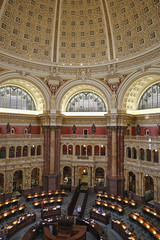Photography Rules Around the National Mall
 The last time I was at the National Archives building in Washington, D.C., I took a mediocre photograph of the very dimly-lit Declaration of Independence on ISO 400 film. A couple of weeks ago I was back, armed with much higher ISO on a Canon 6D digital camera and lens with image stabilization.
The last time I was at the National Archives building in Washington, D.C., I took a mediocre photograph of the very dimly-lit Declaration of Independence on ISO 400 film. A couple of weeks ago I was back, armed with much higher ISO on a Canon 6D digital camera and lens with image stabilization.
To my dismay, the National Archives no longer permits photography of any of their exhibits. They used to allow photography without flash, as flash could promote deterioration of their rare artifacts, but too many people ignored the no-flash rule, either intentionally or unintentionally, and they have now banned photography altogether.
How strict are they about this? I witnessed a guard pounce on a tourist with a mobile phone camera sneaking a picture of the Archives’ copy of the Magna Carta:
“No photography!”
“I’m sorry.”
“You can delete that picture.”
Of course, deleting the picture after the fact doesn’t solve anything regarding artifact deterioration…
Meanwhile, in the third-floor observation deck overlooking the main reading room of the Library of Congress, where photography used to be banned, flash-free photography is now allowed. Sitting inside the reading room, waiting for books to be delivered, I couldn’t help but notice some flashes going off, and it was indeed kind of distracting, but the library didn’t seem as intense about enforcing their newly-loosened rules as the National Archives was about enforcing their increasingly strict rules.
Speaking of rules, I would not have thought that these words would have ever had to be spoken, by a National Archives guard, to a child next to me: “Excuse me, there’s no sitting on the Declaration!”